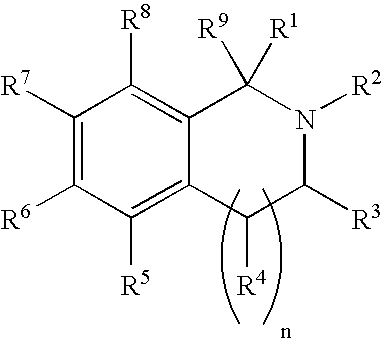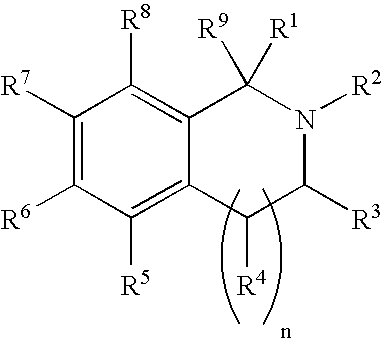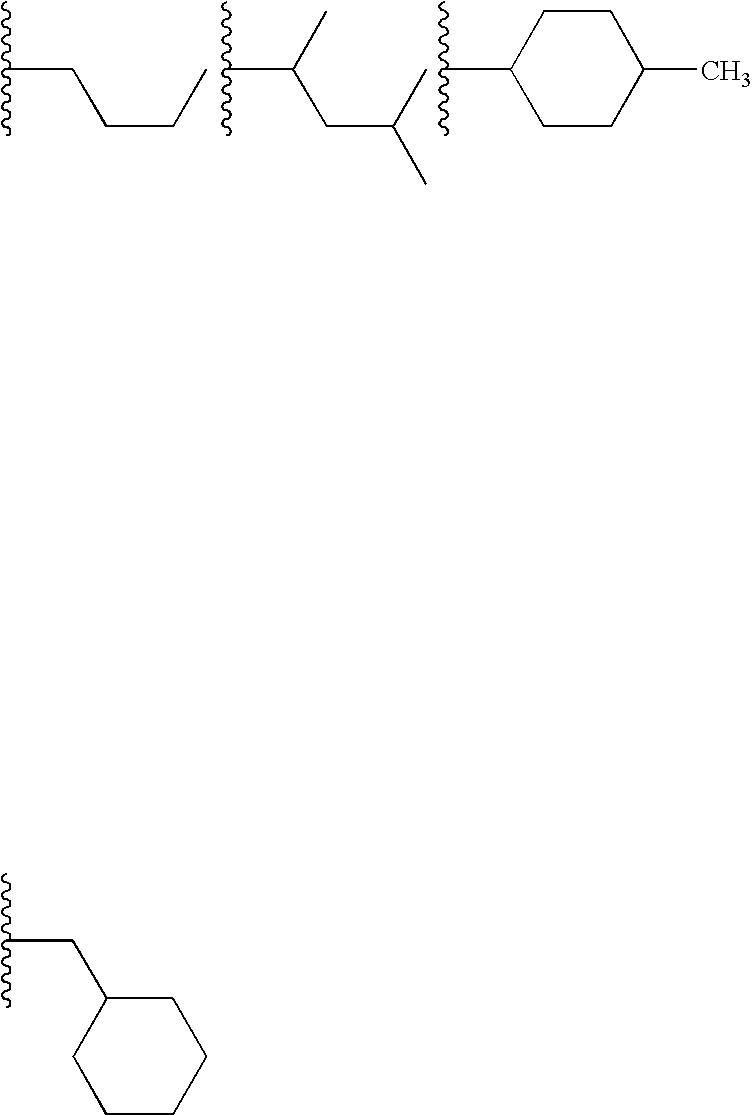Selective estrogen receptor-beta ligands
a technology of estrogen receptor and beta ligand, which is applied in the field of ligands, can solve problems such as limiting its use, and achieve the effect of being useful in the treatment or prophylaxis of alzheimer's
- Summary
- Abstract
- Description
- Claims
- Application Information
AI Technical Summary
Benefits of technology
Problems solved by technology
Method used
Image
Examples
example 1
2-(4-Hydroxyphenyl)-1,2,3,4-tetrahydroisoquinoline-6-ol
1) Synthetic Method A: Synthesis of 6-methoxy-2-(4-methoxyphenyl)-1,2,3,4-tetrahydroisoquinoline
[0092] A solution of 6-methoxy-1,2,3,4-tetrahydroisoquinoline [1] (0.130 g) in toluene (1.75 mL) was added to sodium t-butoxide (0.092 g) in a 5 mL reaction vial equipped with a frit. A suspension of tris(dibenzylideneacetone) dipalladium (0) (0.022 g) and (R)-(+)-2,2′-bis(diphenylphosphino)-1,1′-binaphthyl (0.040 g) in toluene (0.75 mL) was added to the above mixture. The reaction was agitated at 80° C. for 18 h, then cooled and the solids were removed by filtering the reaction through the frit. The filtrate was evaporated and the resulting residue was purified by chromatography on silica gel (eluant: ethylacetate-hexane, gradient from 5:95 to 1:1) to give the title compound (0.065 g). MS: 270.1 (MH+); TLC Rf: 0.33 (20% ethyl acetate hexane); 1H NMR (DMSO-d6): 7.04 (d, 1H, J=8.4 Hz), 6.97 (d, 2H, J=9.2 Hz), 6.86 (d, 2H, J=9.1 Hz), ...
example 2
2-(2-Chloro-4hydroxyphenyl)-1,2,3,4-tetrahydroisoquinoline-6-ol
[0095] According to synthetic methods A and B, from 4-bromo-3-chloroanisole (0.150 g) was obtained 2-(2-chloro-4-methoxyphenyl)-6-methoxy-1,2,3,4-tetrahydroisoquinoline (0.057 g) after purification by chromatography on silica gel (eluant: ethyl acetate-hexane, gradient from 5:95 to 1:1); MS: 304.2 (100%) (MH+), 306.2 (40%) (MH+); TLC Rf: 0.47 (20% ethyl acetate:hexane); and 2-(2-chloro-4-hydroxyphenyl)-1,2,3,4-tetrahydroisoquinoline-6-ol (0.044 g) was obtained after purification by chromatography on silica gel (eluant: a gradient of 0 to 4% methanol in dichloromethane); MS: 276.1 (MH+); HPLC tR: 4.60 min (method C); 1H NMR (MeOD-d4): 7.06 (d, 1H, J=8.7 Hz), 6.90 (d, 1H, J=7.8 Hz), 6.85 (d, 1H, J=2.7 Hz), 6.69 (dd, 1H, J=8.9, 2.9 Hz), 6.60 (d, 1H, J=2.7 Hz), 6.57 (s, 1H), 4.01 (s, 2H), 3.19 (t, 2H, J=5.7 Hz), 2.90 (t, 2H, J=5.7 Hz).
example 3
2-(4-Hydroxy-2-methylphenyl)-1,2,3,4-tetrahydroisoquinolin-6-ol
[0096] According to synthetic methods A and B, from 2-bromo-5-methoxytoluene (0.15 mL) was obtained 6-methoxy-2-(4-methoxy-2-methylphenyl)-1,2,3,4-tetrahydroisoquinoline (0.188 g) after purification by chromatography on silica gel (eluant: ethyl acetate-hexane, gradient from 5:95 to 1:1); MS: 284.1 (MH+); TLC Rf=0.64 (20% ethyl acetate:hexane); and using the compound isolated above (0.094 g), the title compound (0.061 g) was obtained after purification by silica gel chromatography (eluant: a gradient from 0 to 20% methanol in CH2Cl2); MS: 256.0 (MH+; HPLC tR: 0.61 min; 1H NMR (DMSO-d6): 9.12 (s, 1H), 8.97 (s, 1H), 6.93 (d, 1H, J=8.4 Hz), 6.87 (d, 1H, J=8.7 Hz), 6.53-6.60 (m, 4H), 3.81 (s, 2H), 2.95-2.97 (m, 2H), 2.81-2.82 (m, 2H).
PUM
 Login to View More
Login to View More Abstract
Description
Claims
Application Information
 Login to View More
Login to View More - R&D
- Intellectual Property
- Life Sciences
- Materials
- Tech Scout
- Unparalleled Data Quality
- Higher Quality Content
- 60% Fewer Hallucinations
Browse by: Latest US Patents, China's latest patents, Technical Efficacy Thesaurus, Application Domain, Technology Topic, Popular Technical Reports.
© 2025 PatSnap. All rights reserved.Legal|Privacy policy|Modern Slavery Act Transparency Statement|Sitemap|About US| Contact US: help@patsnap.com



